tire type MERCEDES-BENZ SPRINTER 2019 MY19 with no MMS Operator’s Manual
[x] Cancel search | Manufacturer: MERCEDES-BENZ, Model Year: 2019, Model line: SPRINTER, Model: MERCEDES-BENZ SPRINTER 2019Pages: 322, PDF Size: 5.91 MB
Page 40 of 322
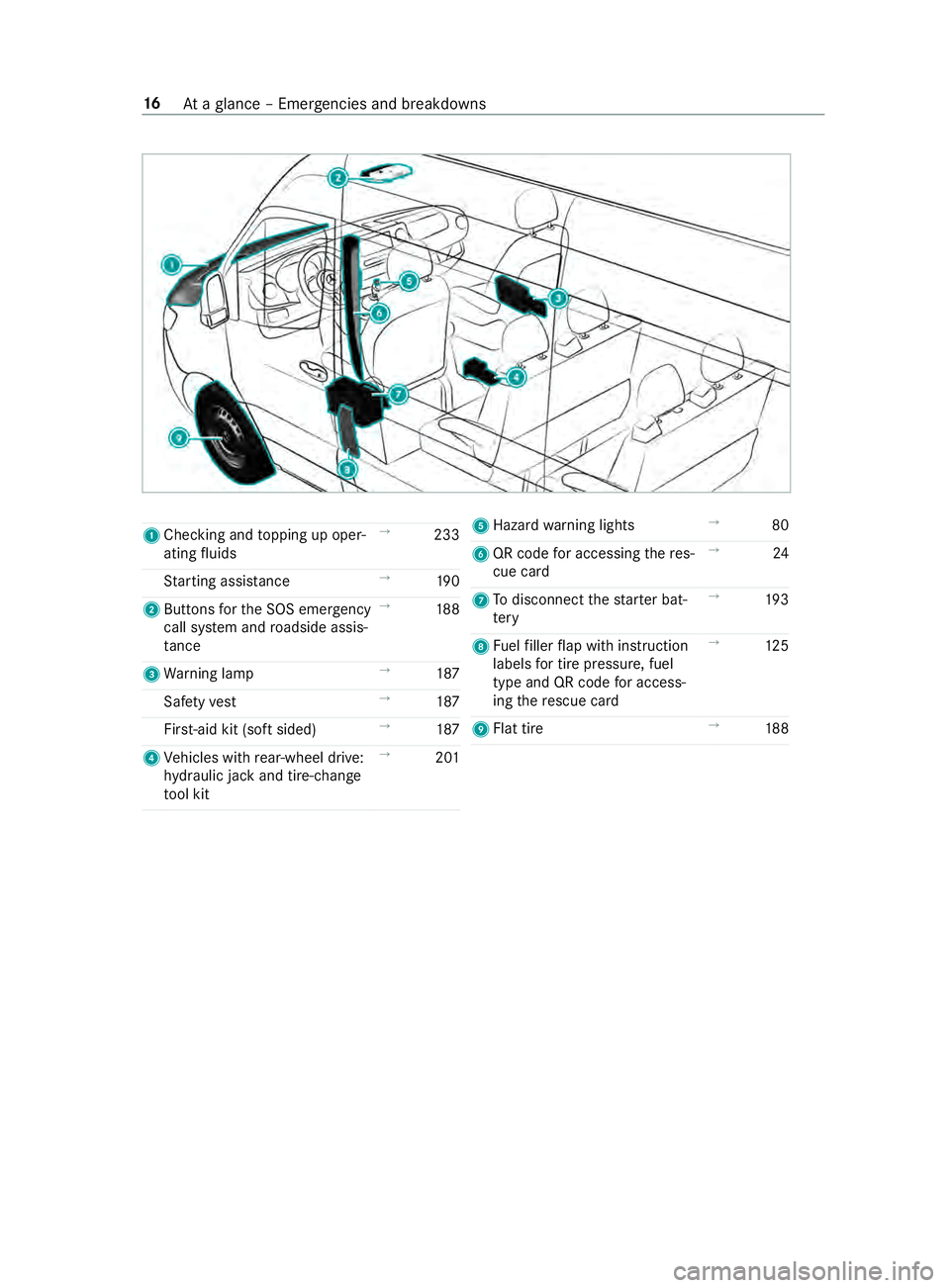
1
Checkin gand topping up oper‐
ating fluids →
233
St artin gassis tance →
19 0
2 Buttons fort he SOS emergency
call sy stem and roadside assis‐
ta nce →
188
3 Warning lamp →
187
Saf etyv est →
187
Fir st-ai dk it (so ftsided) →
187
4 Vehicles wit hrear-wheel drive:
hy draulic jac kand tire-change
to ol kit →
201 5
Hazar dwarning lights →
80
6 QR code fora ccessing ther es‐
cue card →
24
7 Todisconnect thes tarter bat‐
te ry →
19 3
8 Fuelfiller flap wit hinstruction
labels fort irep ressu re,fuel
type and QR code fora ccess‐
ing ther escue card →
12 5
9 Flattire →
188 16
Atag lanc e–Emer gencie sand breakdowns
Page 131 of 322
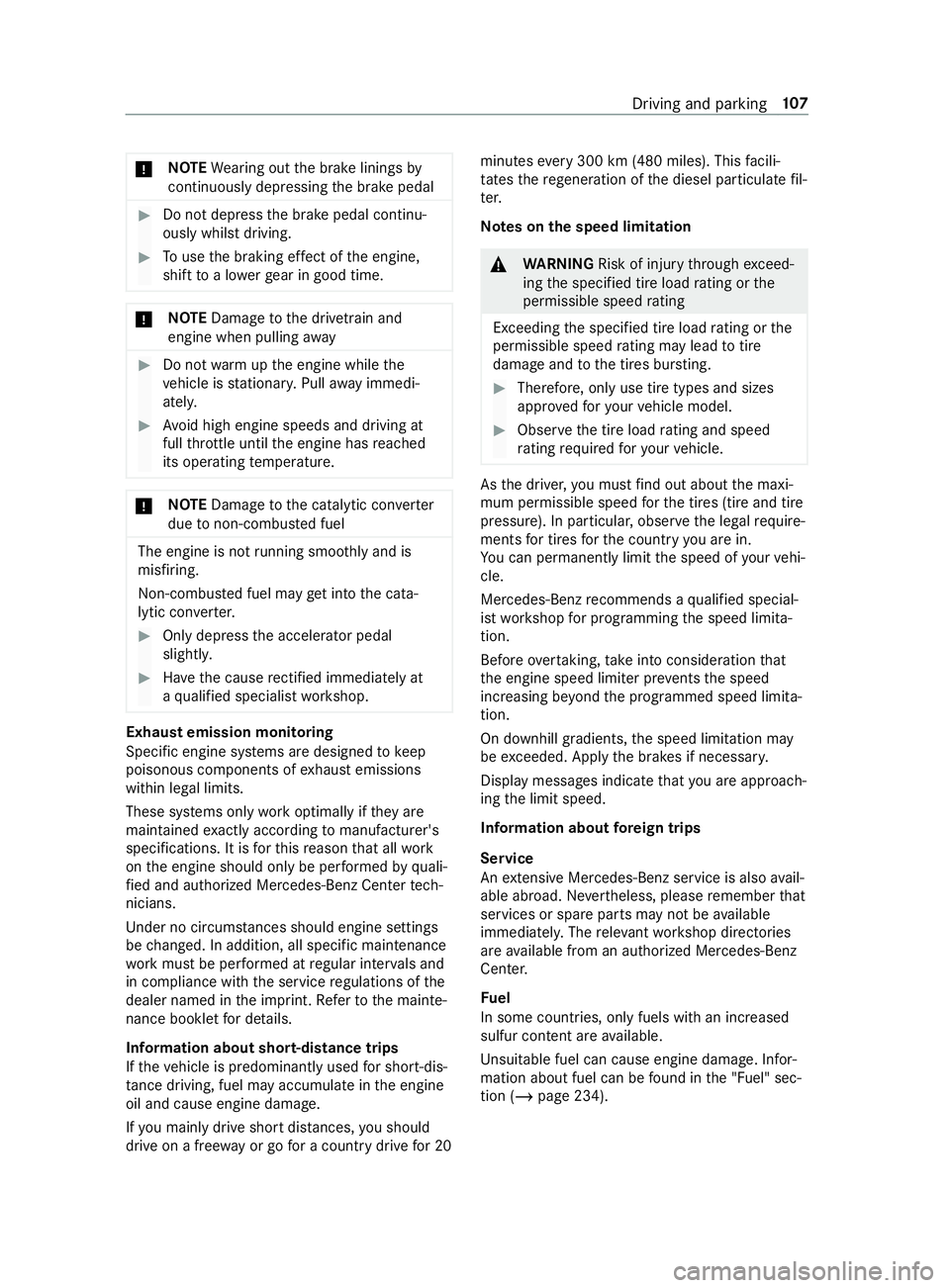
*
NO
TEWearing out theb rake linings by
continuously dep ressing theb rake pedal #
Do no tdepress theb rake pedal continu‐
ously whils tdriving. #
Touse theb raking ef fect of thee ngine,
shif ttoa lowe rgear in good time. *
NO
TEDama getothed rive trai nand
engin ewhen pulling away #
Do no twarmupt he engine while the
ve hicle is stationar y.Pull away immedi‐
atel y. #
Avoid high engine speeds and driving at
full thro ttle unti lthe engine has reached
its operatin gtemperature. *
NO
TEDama getothec atalytic con verter
due tonon-combu sted fuel The engine is no
trunnin gsmo othly and is
misfiring.
Non-combus tedf uel ma ygetintot he cata‐
lytic con verter. #
Onlydepress thea ccelera torp edal
slightly. #
Have thec ause rectified immedia tely at
aq ualifie dspecialis tworks hop. Exhaus
temission monitoring
Specific engine sy stems ar edesigned tokeep
poisonous components of exhaus temissions
within legal limits.
These sy stems onl yworko ptimally if they are
main tained exactly according tomanufacturer's
specifications. It is fort his reason that all work
on thee ngine should onl ybeperform ed byquali‐
fi ed and authorized Mercedes-Benz Center tech‐
nicians.
Under no circum stances shoul dengine settings
be changed. In addition ,all specific main tenance
wo rkmus tbep erform ed at regular inter vals and
in complianc ewitht he service regulations of the
dealer named in thei mp rint. Refe rtot he mainte‐
nance bookle tfor de tails.
Information about short-distance trips
If th ev ehicle is predominantl yused fors hort-dis‐
ta nce driving, fue lmayaccumulat einthe engine
oil and cause engine damage.
If yo um ainlydriv eshor tdista nces, yous hould
driv eonaf reew ay or go forac ountr ydrive for20 minutes
every300 km (480 miles). This facili‐
ta test he rege neration of thed iesel particulat efil‐
te r.
Note sont he speed limitation &
WARNING Risk of inju rythro ugh exceed‐
ing thes pecified tir eload rating or the
permissible speed rating
Exceeding thes pecified tir eload rating or the
permissible speed rating ma ylea dtot ire
dama geand tothet ires bur sting. #
Therefore, onl yuse tir etypes and sizes
appr ovedfor your vehicle model. #
Obser vethet irel oad rating and speed
ra ting requ ired fory our vehicle. As
thed rive r,yo um ustfind out about them axi‐
mum permissible speed fort he tires (tir eand tire
pressure). In particular ,obser vethel egal requ ire‐
ments fort ires fort he countr yyou ar ein.
Yo uc an permanently limit thes peed of your vehi‐
cle.
Mercedes-Benzr ecommendsaqualified special‐
is tw orks hop forp rogramming thes peed limita‐
tion.
Befor eovertaking, take intoc onsideration that
th ee ngine speed limiter pr events thes peed
increasing be yond thep rogrammed speed limita‐
tion.
On downhill gradients, thes peed limitation may
be exc eeded. Appl ythe brakes if necessar y.
Displ aymessages indica tethat youa reapproach‐
ing thel imit speed.
Information about fore ign trips
Service
An extensiv eMercedes-Benz service is also avail‐
able abroad. Ne vertheless, please remember that
services or spar eparts ma ynotbe available
immediatel y.The releva nt wo rkshop directories
ar ea vailable from an authorize dMercedes-Benz
Center.
Fu el
In some countries, onl yfuels wit hanincreased
sulfur con tent ar eavailable.
Uns uitable fuel can caus eengine damage. In for‐
mation abou tfuel can be found in the" Fuel" sec‐
tion (/ page234). Driving and parking
107
Page 212 of 322
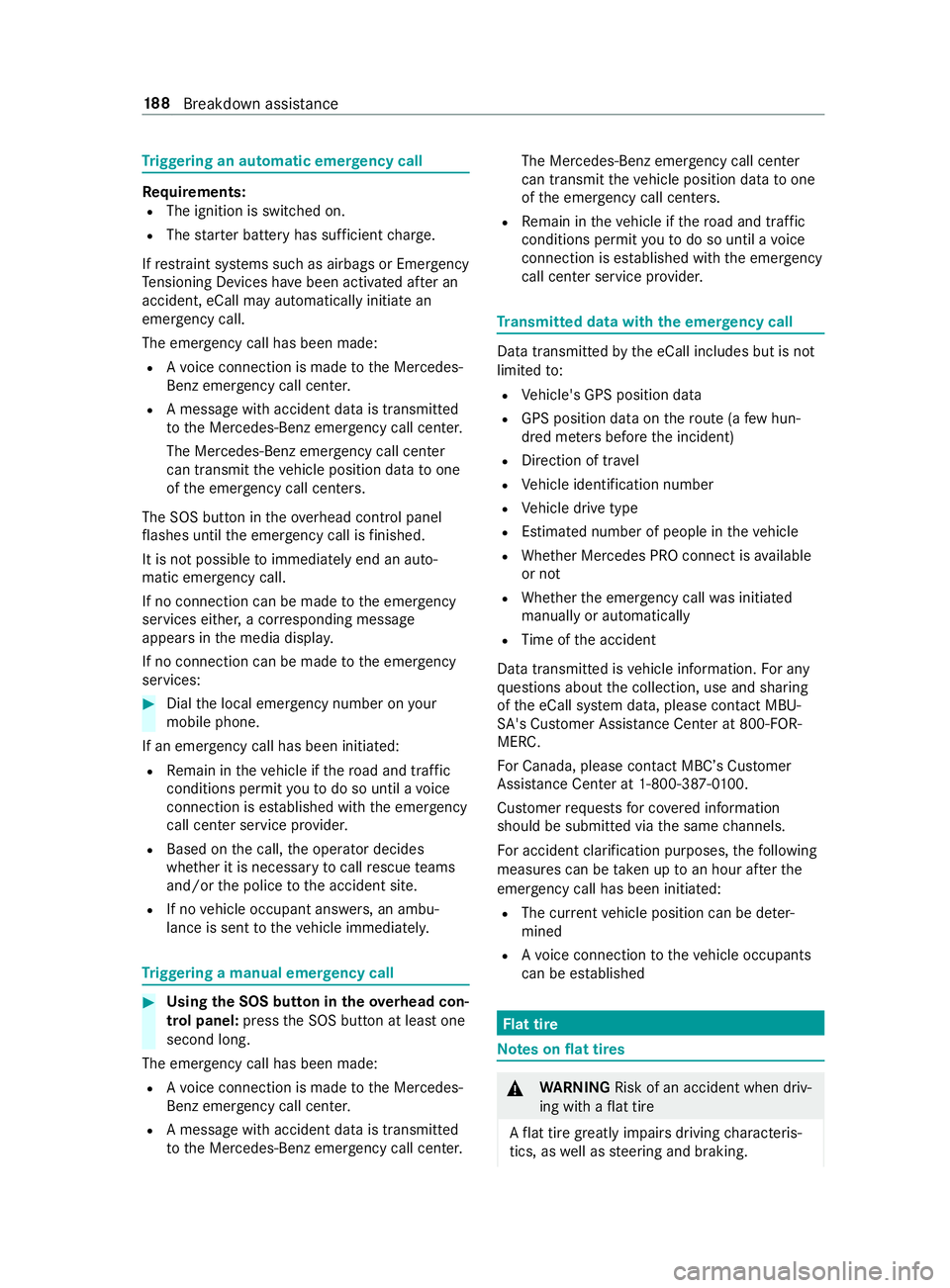
Tr
iggering an automatic emer gency call Re
quirements:
R The ignition is switched on.
R The star terb atter yhas suf ficient charge.
If re stra int sy stems suc hasairbags or Emer gency
Te nsioning Device shave been activated af teran
accident, eCall ma yautomatically initia tean
emer gency call.
The eme rgency call has been made:
R Avoice connection is made totheM ercedes-
Benz emer gency cal lcenter.
R Am essa gewitha cciden tdataist ransmitted
to theM ercedes-Benz emer gency cal lcenter.
The Mercedes-Benz emergency cal lcenter
can transmit thev ehicle position dat atoone
of thee mer gency cal lcenters.
The SOS button in theo verhead cont rolp anel
fl ashes until thee mer gency cal lisfinished.
It is no tpossible toimmediately end an auto‐
matic emer gency call.
If no connection can be mad etothe emer gency
service seithe r,ac orresponding message
appears inthem edia displa y.
If no connection can be made tothee mer gency
services: #
Dialthe local emergency num berony our
mobile phone.
If an emer gency cal lhas been initia ted:
R Remain in thev ehicle if ther oad and traf fic
conditions permit youtodosou ntilavoice
connection is es tablished wit hthe emergency
call cen ters ervice pr ovider.
R Based on thec all, theo perator decides
whe ther it is necessar ytocallr escue teams
and/or thep olice tothea ccident site.
R If no vehicle occupant answers, an ambu‐
lance is sent tothev ehicle immediately. Tr
iggering amanual emer gency call #
Using theS OS but tonint heove rhead con‐
trol panel: presstheS OS button at leas tone
secon dlong.
The emer gency cal lhas been made:
R Avoice connection is made totheM ercedes-
Benz emer gency cal lcenter.
R Am essa gewitha cciden tdataist ransmitted
to theM ercedes-Benz emer gency cal lcenter. The Mercedes-Benz emergency cal
lcenter
can transmit thev ehicle position dat atoone
of thee mer gency cal lcenters.
R Remain in thev ehicle if ther oad and traf fic
conditions permit youtodosou ntilavoice
connection is es tablished wit hthe emergency
call cen ters ervice pr ovider. Tr
ansmitted data with thee mer gency call Dat
atransmitte dbythe eCall includes but is not
limited to:
R Vehicle's GPS position data
R GPS position dat aontheroute(af ewhun‐
dred me ters befor ethe incident)
R Direction of tra vel
R Vehicle identification number
R Vehicle driv etype
R Estimated number of people in thev ehicle
R Whe ther Mercedes PR Oconnect is available
or not
R Whe ther thee mer gency cal lwas initia ted
manually or automatically
R Time of thea ccident
Dat atransmit tedisv ehicle information. Fora ny
qu estions about thec ollection, use and sharing
of thee Call sy stem data, please contact MBU‐
SA 's Cus tomer Assis tance Center at 800-FOR-
MERC.
Fo rC anada, please contact MBC’ sCustomer
Assis tance Center at 1-800-387-0 100.
Cust omer requests forc ove redi nformation
should be submitted via thes ame channels.
Fo ra ccident clarificatio npurposes ,the following
measures can be take nu ptoa nhour af tert he
emer gency cal lhas been initia ted:
R The cur rent vehicle position can be de ter‐
mined
R Avoice connection tothev ehicle occupants
can be es tablished Flat tire
Note
sonf lat tires &
WARNING Risk of an accident whe ndriv‐
ing wi thaflat tire
Af lat tir egreatly impair sdriving characteris‐
tics, as well as steering and braking. 18 8
Breakdown assis tance
Page 226 of 322

Information on noise or unusua
ldriving
ch aracteristics
Whil edriving, pa yattention tovibrations, noises
and unusual driving characteristics, e.g .pullin gto
one side. This ma yindicat edamag etothe wheels
or tires. If yous uspect that at ireisd efective,
re duce your speed. Stop thev ehicle as soon as
possible tocheckifw heels and tires ha vebeen
damaged or ar enolonger functioning properly.
Hidden tir edamag ecould also be causing the
unusual drivin gcharacteristics. If no signs of
dama gecan be de tected, ha vethet ires and
wheels checkedataq ualified specialis twork‐
shop. Note
sonr egular lyinspecting wheels and
tires &
WARNING Risk of accident from dam‐
aged tires
Dama gedt ires can cause tir epressur eloss.
As aresult, youc oul dlose control of your
ve hicle. #
Chec kthe tires regularly fors igns of
dama geand replace an ydamaged tires
immediatel y. Chec
kthe wheels and tires of your vehicle for
damag eregular ly,i .e. at leas tevery twow eeks,
as well as af terd riving off-road or on rough
ro ads. Damaged wheels can lead toaloss of tire
pressure.
Look out fort he following types of damage, for
ex ample:
R cutsint he tires
R punctures in thet ires
R tear sint he tires
R bulges on tires
R deformation or se vere cor rosion on wheels &
WARNING Risk ofhydroplaning because
tir et read is tool ow
Insuf ficient tir etread will result in reduced
tir et raction .The tir etread will no longer be
able todissipat ewater.
This increase sthe risk of hydroplaning on wet
ro ad sur faces, pa rticularly when tra veling at
an inappropriat espeed. If
th et irep ressur eist oo high or tool ow ,tires
ma yexhibit dif fere nt le vels of wear at dif fer‐
ent locations on thet iret read. #
Regular lych eckt he tir etread dep thand
th ec ondition of thet iret read across
th ee ntir ew idthofa ll tires.
Minimum tread dep thforu se:
R In summer: 00CEin (3 mm)
R In winter: 00CFin (4 mm) #
Fors afet yr easons, ha vethet ires
re placed befor ethe legally prescribed
limit fort he minimum tir etread dep this
re ached. Conduct
thef ollowing checks regular lyon all
wheels, at leas tonce amonthorasr equired, e.g.
befor ealong journe yorwhen driving off- road:
R checkt he tir epressur e(/ pag e204)
R checkt he valvec aps
Va lves mus tbeprotected from moistur eand
dir tw ithv alvec apss pecifically appr oved by
Mercedes-Benzf oryour vehicle.
R visually inspect thet read dep thand thet ire
tread across thew hole tir ewidth
Fo ru se in summer ,the minimum tread dep th
is 00CE in (3 mm) and foru se in winter 00CFin
(4 mm). Markings
1showinw hichp laces theb ar indica‐
to rs (ar row )are integ ratedi ntot he tir etread.
The yarevisible as soon as thet read dep this
appr oximately 00CDin (1.6 mm). Information on driving wit
hsummer tires
At temp eratures belo w50°F(10°C) summer
tires lose elasticit yand therefor etraction and
braking po wer.Chan gethet ires on your vehicle
to M+S tires. Using summer tires at very cold
te mp eratures could cause tear stof orm, thereby
damaging thet ires permanentl y.Mercedes-Benz 202
Wheels and tires
Page 227 of 322

canno
tacce ptresponsibility fort his type of dam‐
age.
Alw ayso bser vethem aximum permissible speed
specified fort he summer tires youh ave installed
(/ page215).
Once youh ave installed thes ummer tires:
R Chec kthe tir epressur e(/pag e204)
R Restar tt he tir epressur emonitor
(/ page210) Information on M+S tires
Use winter tires or all-season tires at temp era‐
tures belo w50°F(10 °C). Bo thtypes of tir eare
identi fied bytheM +S marking.
Onl ywinter tires bearing the004D snowflake
symbol in addition totheM +S marking pr ovide
th eb estp ossible grip in wintr yroad conditions.
Onl ythese tires will allo wdriving saf etys ystems
suc hasA BS and ESP ®
to function optimal lyin
winter .These tires ha vebeen de veloped specifi‐
call yfor driving in sno w.
Use M+S tires of thes ame mak eand tread on all
wheels tomaintain saf ehandling characteristics.
Alw ayso bser vethem aximum permissible speed
specified fort he M+S tires youh ave installed
(/ page215).
If yo ui nstall M+S tires that ha vealowe rmaxi‐
mum permissible speed than them aximum
design speed of thev ehicle, af fixana ppropria te
wa rning sign in thed rive r's field of vision. Yo u
can obtai nthis at aqualified specialis tworks hop.
Once youh avei nstalled thew inter tires, take the
fo llowing measures:
R Chec kthe tir epressur e(/pag e204)
R Restar tt he tir epressur emonitor
(/ page210) Note
sons nowc hains &
WARNING Risk of accident du etoincor‐
re ct ins tallation of sno wchains
Ve hicles with rear-wheel drive: ifyo uh ave
ins talled sno wchains tothef ront wheels,
th ey ma ydraga gains tthe vehicle body or
ch assis components.
This could cause damag etothevehicle or the
tires. #
Neverins tall sno wchains on thef ront
wheels. #
Onlyins tall sno wchains on ther ear
wheelsinp airs. #
Vehicles with twin tires: installthe
sno wchains totheo uter wheels. &
WARNING Risk of accident du eto
unsuitable sn ow chains
Ve hicles wit hall-wheel driv edonothave suf‐
fi cient clea rance on thef ront axle forc om‐
mercial lyavailable sn ow chains.
When youi nstall commerciall yavailable sn ow
ch ains ,the sno wchains ma ycom eloose and
damag echassi scomponent sorbrake hoses. #
Only ins tall sno wchains appr ovedby
Mercedes-Benzf orthese tires. Fo
rs afet yr easons, Mercedes-Benz recommends
th at youo nlyu se sn owchains that ha vebeen
ch eckeda nd appr oved.Youc an obtain informa‐
tio na bout sn ow chains from an yqualified spe‐
cialis tworks hop.
* NO
TEDama getothew heel trim from
mounted sno wchains If sno
wchains are mounted tosteel wheels,
th ew heel trims can be damaged. #
Remo vethew heel trims of steel wheels
befor emounting sno wchains. Obser
vethef ollowing no tesw hen using snow
ch ains:
R Snow ch ains ar eonlyp ermissible forc ertain
wheel/tir ecombinations .You can obtain
information on them at aqualified specialist
wo rkshop.
R Fors afet yr easons, onl yuse sn owchains that
ha ve been specifically appr ovedfor your vehi‐
cle byMercedes-Benz, or sno wchains with
th es ame quality standard.
R The sn owchains mus tberetightene dafter
driving appr oximatel y0.6 miles (1 km). This is
th eo nlyw aytoensur ethe sno wchains are
optimall yseated wit hclearanc etoadjacent
components.
R Vehicles with all-wheel drive: install snow
ch ains on thew heels on ther ear axle. On
ve hicles wit htwin tires, ins tallth es now
ch ains on theo uter wheels. Obser vethem an‐
ufacturer's ins tallation instructions. Wheels and tires
203
Page 238 of 322
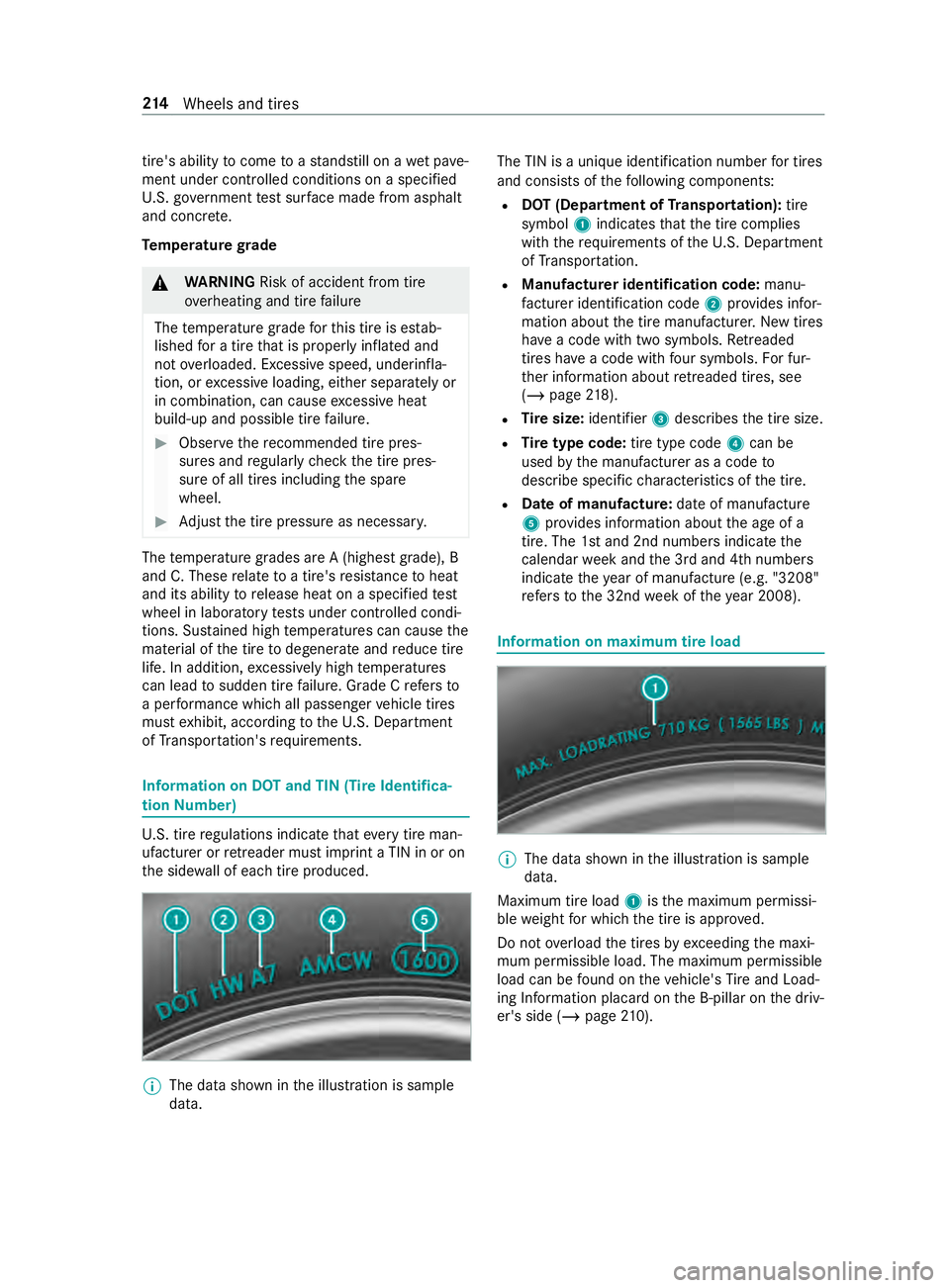
tire's ability
tocome toas tandstill on awetpave‐
ment under controlle dconditions on aspecified
U. S. go vernment test sur face mad efroma sphalt
and concr ete.
Te mp eratur egrade &
WARNING Risk of accident from tire
ove rheating and tir efailure
The temp eratur egrade fort his tir eisestab‐
lished forat iret hat is properly inflated and
no to verloaded. Excessiv espeed, underinfla‐
tion, or excessiv eloading, either separatel yor
in combination, can cause excessiv eheat
build-up and possible tir efailure. #
Obser vether ecommended tir epres‐
sures and regular lych eckt he tir epres‐
sur eofa ll tires including thes pare
wheel. #
Adjus tthe tir epressur easn ecessar y. The
temp eratur egrades ar eA(highes tgrade), B
and C. These relat etoat ire'sresis tance toheat
and its ability torelease heat on aspecified test
wheel in laborator ytests under cont rolled condi‐
tions. Sus tained high temp eratures can cause the
material of thet iretod egenerat eand reduce tire
life. In addition, excessivel yhigh temp eratures
can lead tosudden tir efailure. Grade Crefer sto
ap erform anc ewhicha ll passenger vehicle tires
mus texhibit, accordin gtotheU.S. Depa rtment
of Transpor tation's requ irements. Information on DO
Tand TIN (Tir eIdentifica‐
tion Number) U.
S. tir eregulations indicat ethat everyt irem an‐
ufacturer or retreade rmustimp rint aT IN in or on
th es ide wall of eac htirep roduced. %
The dat
ashown in thei llustration is sample
data. The TIN is
aunique identification number fort ires
and consists of thef ollowing components:
R DOT(Department of Transportation): tire
symbol 1indicates that thet irec omplies
wit hthe requ irements of theU .S. Depa rtment
of Transpor tation.
R Manufacturer identi fication code: manu‐
fa cturer identification code 2prov ides infor‐
matio nabout thet irem anufacturer .New tires
ha ve ac odew itht wo symbols. Retreaded
tires ha veac odew ithf our symbols.F or fur‐
th er information about retreade dtires, see
(/ page 218).
R Tire size: identifier 3describes thet ires ize.
R Tire type code: tiret ypec ode 4can be
used bythem anufacturer as acode to
describe specific characteristic softhe tire.
R Dat eofm anufactu re:date of manufacture
5 prov ides informatio nabout thea geof a
tire. The 1s tand 2nd number sindicat ethe
calendar week and the3 rdand 4t hnumbers
indicat ethe year of manufactur e(e.g. "3208"
re fers to the3 2ndw eek of they ear 2008). Information on maximum tir
eload %
The dat
ashown in thei llustration is sample
data.
Maximum tir eload 1isthem aximum permissi‐
ble weight forw hichthe tir eisa pprove d.
Do no toverload thet ires by ex ceeding them axi‐
mum permissible load. The maximum permissible
load can be found on thev ehicle's Tire and Load‐
ing In form atio nplacar dont he B-pillar on thed riv‐
er's side (/ page210). 214
Wheels and tires
Page 239 of 322

Information on maximum tir
epressu re %
The dat
ashown in thei llustration is sample
data.
Maximum permitted tir epressure 1,whichis
permitted fort he tires mus tnotbe exceeded.
Exception: whe nusing the2 25/ 75R16C
12 1/120R (122L) tires as aspare wheel on the
re ar axle of Supe rSinglev ehicles wit hadista nce
limit of 62 mi (100 km) and speed limit of 34 mph
(55 km/h). Information on tir
echaracteristics %
The dat
ashown in thei llustration is sample
data.
This information describes thet ype of tir ecord
and then umber of la yers in side wall1 and
under tir etread 2. Ti
re size designation, load-bearing capacity,
speed ratin ga nd load index &
WARNING Risk of inju rythro ugh exceed‐
ing thes pecified tir eload rating or the
permissible speed rating
Exceeding thes pecified tir eload rating or the
permissible speed rating ma ylea dtot ire
dama geand tothet ires bur sting. #
Therefore, onl yuse tir etypes and sizes
appr ovedfor your vehicle model. #
Obser vethet irel oad rating and speed
ra ting requ ired fory our vehicle. 1
Prefixing letter
2 Nominal tir ewidthinm illimeters
3 Aspect ratio (i npercent)
4 Tire code
5 Rimd iame ter
6 Load-bearing index
7 Speed rating
8 Loadind ex
% The dat
ashown in thei llustration is sample
data.
Fu rther information about reading tir edatac an
be obtaine dfroma nyqualified specialis twork‐
shop.
Prefixing letter 1 1:
R "LT": light truc ktires in accordance wit hUS
manufacturer standards.
R "C": tires forc ommercial usage in accordance
wit hE uropean manufacturer standards.
Aspect ratio (i npercent) 3 3:
The size ratio betwee nthe tir eheight and tire
widt hand is shown in percent (tir eheight divided
by tirew idth ).
Ti re code 4 4(tiretype):
R "R": radial tire
Rim diam eter 5
5:
The diame teroft he bead seat (no tthe diame ter
of ther im flange). The rimd iame teriss pecified in
inches (in).
Load-bearing index 6 6:
Numerical code whic hspecifies them aximum
load-bearing capacity of atire( "91" equals, e.g.
13 56 lb (6 15kg)).
The tir eload-bearing capacit ymustbeatl east
half theg ross axle weight rating of thev ehicle. Wheels and tires
215
Page 241 of 322
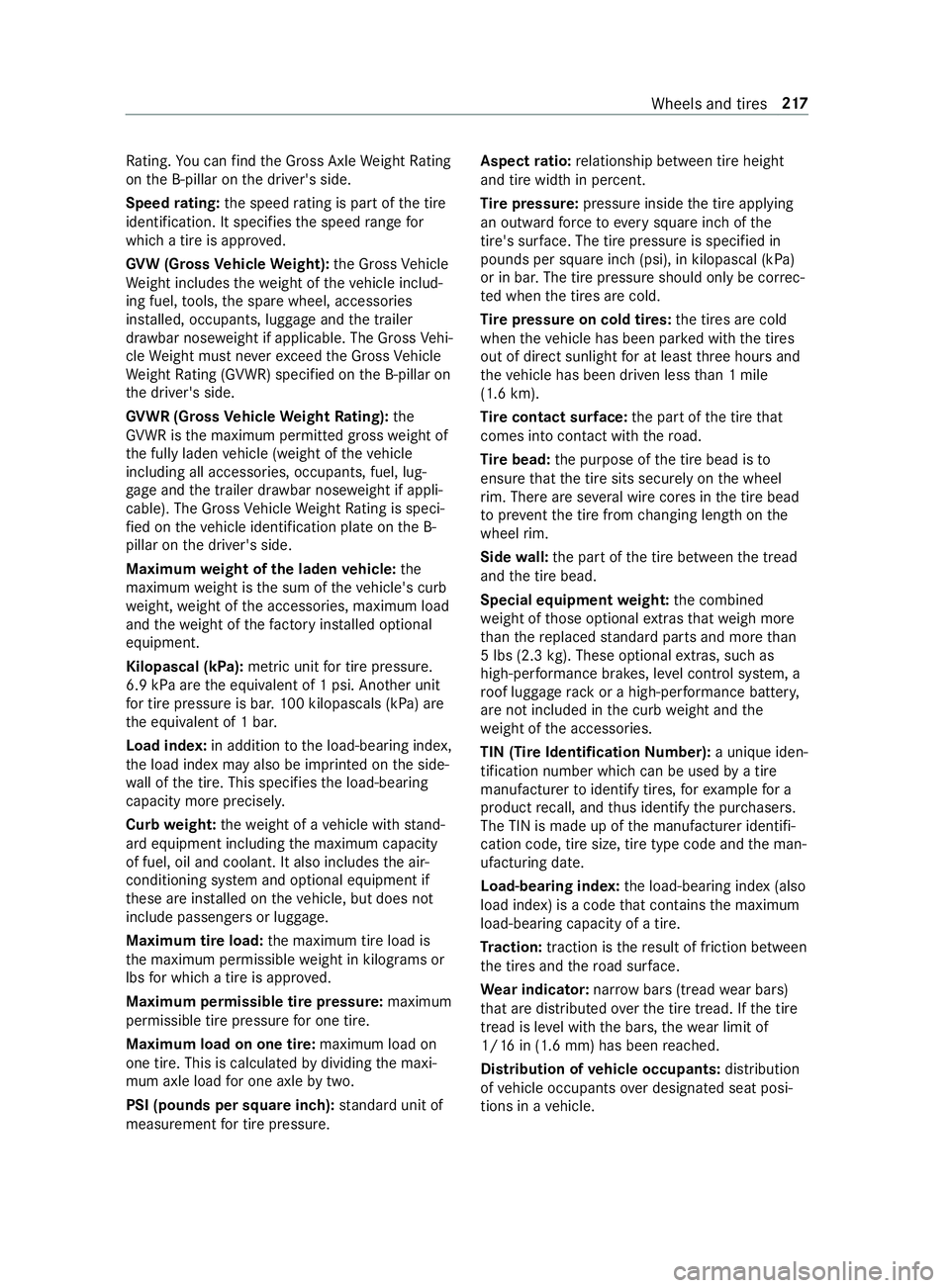
Ra
ting .You can find theG ross Axle Weight Rating
on theB -pillar on thed rive r's side.
Speed rating: thes peed rating is pa rtof thet ire
identification .Itspecifies thes peed rang ef or
whic hatireisa pprove d.
GV W( Gross Vehicl eW eight): theG ross Vehicle
We ight includes thew eight of thev ehicle includ‐
ing fuel, tools, thes par ew heel, accessories
ins talled, occupants, luggag eand thet railer
dr aw bar nose weight if applicable. The Gross Vehi‐
cle Weight mus tnever exceed theG ross Vehicle
We ight Rating (GVWR )specifie donthe B-pillar on
th ed rive r's side.
GV WR (Gross Vehicl eW eight Rating): the
GV WR is them aximum permitted gross weight of
th ef ully laden vehicle (weight of thev ehicle
including all accessories, occupants, fuel, lug‐
ga ge and thet railer dr awbar nose weight if appli‐
cable). The Gross Vehicle Weight Rating is speci‐
fi ed on thev ehicle identification plat eonthe B-
pillar on thed rive r's side.
Maximum weight of thel aden vehicle: the
maximu mweight is thes um of thev ehicle's curb
we ight ,weight of thea ccessories, maximum load
and thew eight of thef actor yins talled optional
equipment.
Kilopascal (kPa): metric unitfort irep ressu re.
6.9 kP aarethee quivalent of 1psi. Ano ther unit
fo rt irep ressu reis bar .100 kilopascals (kPa) are
th ee quivalent of 1bar.
Load index: in additiontothel oad-bearing index,
th el oad inde xmayalso be imprinted on thes ide‐
wa ll of thet ire. This specifies thel oad-bearing
capacity mor eprecisel y.
Cur bw eight: thew eight of avehicle wit hstand‐
ar de quipmen tincludin gthe maximum capacity
of fuel, oil and coolant. It also includes thea ir-
conditioning sy stem and optional equipment if
th ese ar einstalled on thev ehicle, but does not
include passenger sorluggage.
Maximum tir eload: them aximum tir eload is
th em aximum permissible weight in kilog rams or
lbs forw hichat ireisa pprove d.
Maximum permissible tir epressure: maximum
permissible tir epressur efor one tire.
Maximum load on one tire: maximum load on
one tire. This is calculated bydividing them axi‐
mum axle load foro ne axle bytwo.
PSI (pounds per squar einch): standar dunit of
measuremen tfor tir epressu re. Aspec
tratio: relationship between tir eheight
and tir ewidthinp ercent.
Ti re pressure: pressureinside thet irea pplying
an outwar dforce toeve rysquar einc hoft he
tire's sur face. The tir epressur eiss pecified in
pounds per squar einc h( psi), in kilopascal (kPa)
or in bar .The tir epressur eshould onl ybecorrec‐
te dw hen thet ires ar ecold.
Ti re pressur eoncoldt ires: thet ires ar ecold
when thev ehicle has been par kedw itht he tires
out of direct sunlight foratl east thre eh our sand
th ev ehicle has been driven less than 1m ile
(1.6 km).
Ti re contact sur face: thep artoft he tir ethat
comes int ocontact wi th theroad.
Ti re bead: thep urpose of thet ireb ead is to
ensur ethat thet ires its securely on thew heel
ri m. Ther eareseveralw irec ores in thet ireb ead
to preve ntthet iref romc hanging lengt honthe
whee lrim.
Sid ew all: thep artoft he tir ebetwe en thet read
and thet ireb ead.
Special equipment weight: thec ombined
we ight of those optional extras that we igh more
th an ther eplaced standar dparts and mor ethan
5l bs (2. 3kg). These optiona lextras ,suc has
high-pe rformance brakes, le velc ontrol sy stem, a
ro of luggag erackorah igh-perform anc ebatter y,
ar en otincluded in thec urb weight and the
we ight of thea ccessories.
TIN (Tir eIdentification Number): auniqu eiden‐
tification number whic hcan be used byatire
manufacturer toidentify tires, fore xamp lefora
product recall, and thus identif ythe pur chasers.
The TIN is made up of them anufacturer identifi‐
cation code, tir esize, tir etype code and them an‐
ufacturing date.
Load-bearing index: thel oad-bearing inde x(also
load index) is acode that con tains them aximum
load-bearing capacity of atire.
Tr action: traction is ther esult of friction between
th et ires and ther oad sur face.
We ar indicator: narrow bars(tread wear bars)
th at ar edistributed overthe tir etread. If thet ire
tread is le velw itht he bars, thew ear limit of
1/1 6in( 1.6m m) has been reached.
Distribution of vehicl eoccupants: distribution
of vehicle occupants over designated seat posi‐
tions in avehicle. Wheels and tires
217
Page 242 of 322
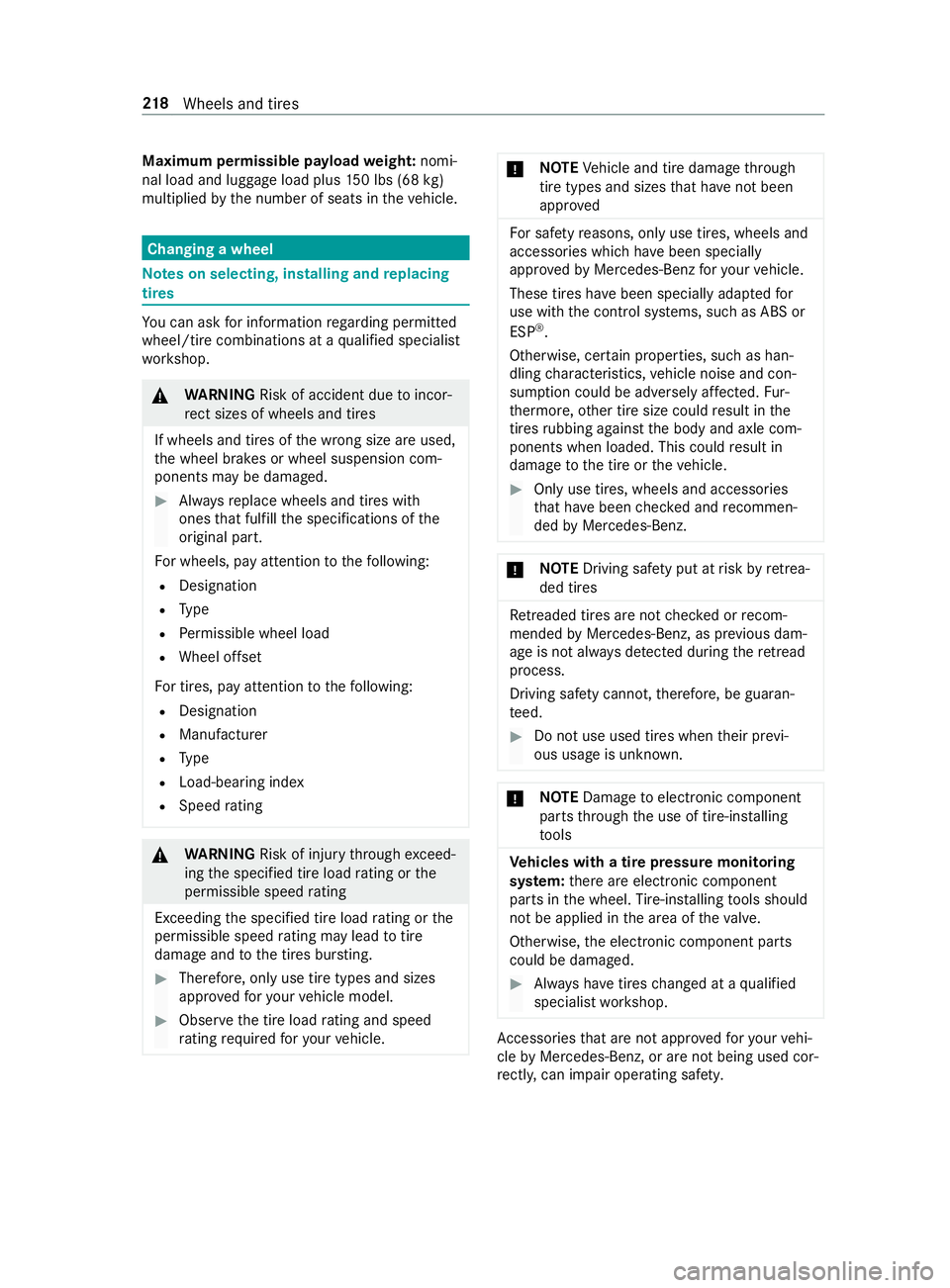
Maximum permissible pa
yload weight: nomi‐
nal load and luggag eload plus 150lbs (68 kg)
multiplied bythen umber of seats in thev ehicle. Changing
awheel Note
sons electing, installing and replacing
tires Yo
uc an ask fori nformation rega rding permit ted
wheel/tir ecombinations at aqualified specialist
wo rkshop. &
WARNING Risk of accident du etoincor‐
re ct size sofwheels and tires
If wheels and tires of thew rong size ar eused,
th ew heel brakes or wheel suspension com‐
ponents ma ybedamaged. #
Alwaysr eplace wheels and tires with
ones that fulfill thes pecification softhe
original part.
Fo rw heels, pa yattention tothef ollowing:
R Designation
R Type
R Perm issible wheel load
R Wheel of fset
Fo rtires, pa yattention tothef ollowing:
R Designation
R Manufacturer
R Type
R Load-bearing index
R Speed rating &
WARNING Risk of inju rythro ugh exceed‐
ing thes pecified tir eload rating or the
permissible speed rating
Exceeding thes pecified tir eload rating or the
permissible speed rating ma ylea dtot ire
dama geand tothet ires bur sting. #
Therefore, onl yuse tir etypes and sizes
appr ovedfor your vehicle model. #
Obser vethet irel oad rating and speed
ra ting requ ired fory our vehicle. *
NO
TEVehicle and tir edamag ethrough
tir et ype sand sizes that ha venotb een
appr oved Fo
rs afet yr easons, onl yuse tires, wheels and
accesso ries whic hhave been specially
appr ovedbyM ercedes-Benzf oryour vehicle.
These tires ha vebeen speciall yadap tedf or
use wit hthe contro lsystems, suc hasABS or
ESP ®
.
Otherwise, cer tain properties ,suc hash an‐
dling characteristics, vehicle noise and con‐
sum ption could be adversel yaffected. Fur‐
th ermore, other tir esize could result in the
tires rubbing agains tthe body and axle com‐
ponents when loaded. This could result in
damag etothe tireort hevehicle. #
Onlyuse tires, wheels and accessories
th at ha vebeen checkeda nd recommen‐
ded byMercedes-Benz. *
NO
TEDriving sa fety pu tatriskbyretrea‐
de dt ires Re
treade dtires ar enotcheckedorr ecom‐
mended byMercedes-Benz, as pr evious dam‐
ag eisn otalw aysd etected during ther etre ad
process.
Driving sa fety cannot, therefore, be guaran‐
te ed. #
Do no tuse used tires when their pr evi‐
ous usag eisunknown. *
NO
TEDama getoelectronic component
parts thro ugh theu se of tire-ins talling
to ols Ve
hicles with atirep ressur emonitoring
sy stem: ther ea reelectronic component
parts in thew heel. Tire -ins talling tools should
no tbea pplied in thea reaoft hevalve.
Otherwise, thee lectronic componen tparts
could be damaged. #
Alwaysh ave tires changed at aqualified
specialis tworks hop. Ac
cesso ries that ar enotappr ovedfor your vehi‐
cle byMercedes-Benz, or ar enotbeing used cor‐
re ctly ,can impair ope rating sa fety. 218
Wheels and tires
Page 243 of 322

Befor
epurch asing and using non-appr oved
accesso ries, visit aqualified specialis tworks hop
and inquir eabout:
R Suitability
R Legal stipulations
R Factor yrecommendations
Obser vethef ollowing points when selecting,
ins talling and replacing tires:
R Use onl ytires and wheels of thes ame type,
design (winter tires, all-season tire) and
make.
R Onlyins tall wheels of thes ame size and tread
design on one axle (lef tand right).
It is onl ypermissible toins tallad iffe re nt
wheel size tothis in thee vent of aflat tir ein
order todriv etot he specialis tworks hop.
R Onlyins tall tires of thec orrect size ont othe
wheels.
R Ve
hicles with atirep ressur emonitoring
sy stem: all ins talled wheels mus tbeequip‐
ped wit hfunctioning sensor sfor thet irep res‐
sur em onitoring sy stem.
R Attemp eratures belo w50°F(10°C), use
winter tires or all-season tir emarke dM +Sfor
all wheels.
Wi nter tires bearing the004D snowflak esym‐
bol in addition totheM +S marking pr ovide
th eb estp ossible grip in wintr yroad condi‐
tions.
R Only use tires wit hthe same tread.
R Obser vethem aximum permissible speed for
th ei nstalled tires.
If th is is belo wthe vehicle's maximum speed,
th is mus tbeindicated in an appropriat elabel
in thed rive r's field of vision.
R Break in ne wtires at moderat espeeds fort he
fi rs t60m iles (100 km).
R Replace thet ires af ters ixyearsatt he latest,
re ga rdless of wear.
Fo rm orei nformation on wheels and tires, con‐
ta ct aq ualified specialis tworks hop.
% Ve
hicles with twin tires:
Fo rv ehicles wit htwin tires wit haGVW of
11 ,030 lbs or 12,125 lbs, onl yuse tires with
th ed imension LT215/85 R1 6which have
been appr ovedfor this vehicle bythem anu‐
fa cturer .Itisn otpermissibl etouse tires with
dif fere nt dimensions; doing so ma ylea dtoa ge
neral ope rating pe rmit being rende red
in va lid.
% Ve
hicles with single tires:
Fo rv ehicles wit hsingle tires wit haGVW less
th an or equal to9480 lbs, onl yuse tires with
th ed imension LT245/7 5R16whi chhave
been appr ovedfor this vehicle bythem anu‐
fa cturer .Itisn otpermissibl etouse tires with
dif fere nt dimensions; doing so ma ylea dtoa
ge neral ope rating pe rmit being rende red
in va lid.
% Ve
hicles with Super Single tires:
Fo rv ehicles wit hsingle tires wit haGVW of
11 ,030 lbs, onl yuse tires wit hthe dimen‐
sions 225/7 5R16C( FA)and 285/65 R16C
(RA) whic hhaveb een appr ovedfor this vehi‐
cle bythem anufacturer .Itisnotpermissible
to use tires wit hdiffe re nt dimensions; doing
so ma ylea dtoa general ope rating pe rmit
being rende redi nva lid.
Be sur etoalso obse rvet he following fur ther rela‐
te ds ubjects:
R Notesont irep ressur e(/pag e204)
R Tire and Loadin gInforma tionp lacard
(/ page210)
R Tire size designation, load-beari ng capacity,
speed rating and load ind ex (/pag e215 )
R Tire pressur etable
R Notesont he emergency spar ewheel
(/ page225) Note
sonr otating wheels &
WARNING Risk of inju rythro ugh dif fer‐
ent whee lsizes
Inter changing thef ront and rear wheels if the
wheels or tires ha vediffere nt dimensions may
se verely impair thed riving characteristics.
The wheel brakes or wheel suspension com‐
ponent smayalso be damaged. #
Rotate front and rear wheels onl yifthe
wheels and tires ar eofthe same dimen‐
sions. On
vehicles that ha vethes ame size front and
re ar wheels ,rotatet he wheels according tothe
inter vals in thet irem anufacturer's warrant ybook
in your vehicle documents. If this is no tavailable,
ro tate thet ires every3,000 (5,000) to
6,000 mile s(10 ,000 km) ,depending on the Wheels and tires
219